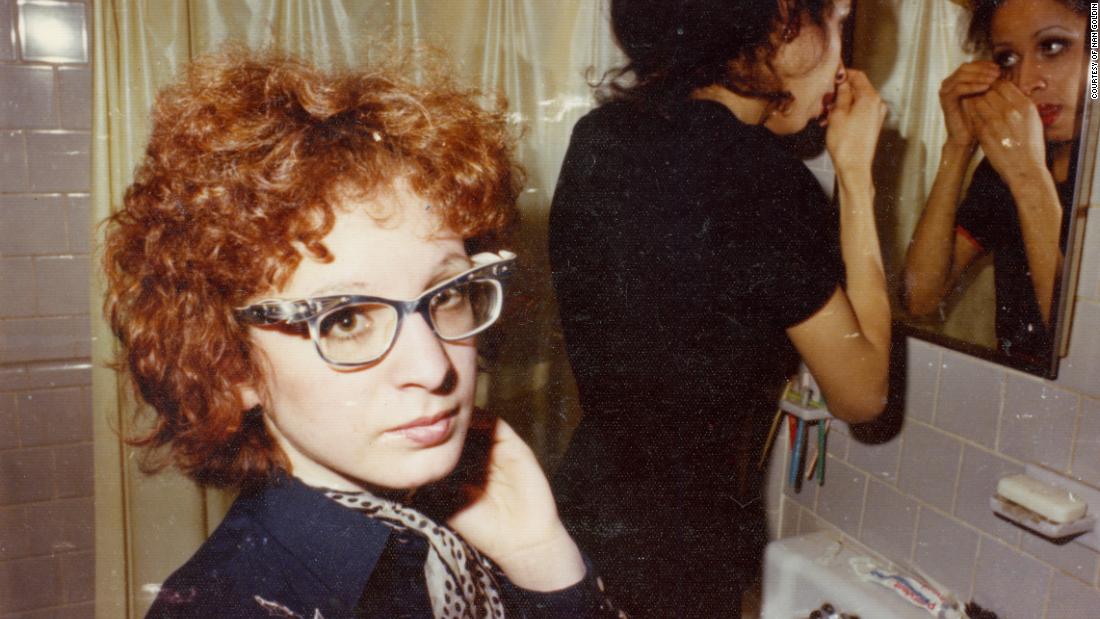
Among those documenting the protests was Goldin herself, working with the activist group she cofounded called P.A.I.N (Prescription Addiction Intervention Now). Knowing the artist wanted to create a film about what they were doing, the group filmed with producer-friends for months until Goldin met Laura Poitras, an Oscar-winning director who would make it a reality.

“All the Beauty and the Bloodshed” features the artist’s photography archive. Shown here is “Self portrait with scratched back after sex,” London, 1978, by Nan Goldin. Credit: Courtesy of Nan Goldin
Entwined with that thread is a defiant and devastating retelling of the artist’s decades of activism and life among New York’s LGBTQ subculture. Then, there is the story of Goldin’s own family tragedy.
Cycle of misplaced stigma
The notion of reconfiguration is one Poitras would embrace when she began to learn about Goldin’s older sister, Barbara, who ultimately became the film’s emotional throughline.

Nan Goldin (right) and her sister, Barbara, holding hands. Credit: Courtesy of Nan Goldin
Poitras sat down with Goldin for a series of off-camera interviews during the making of the documentary. Goldin would bring along family photographs and request more interviews, inviting the director to dig deeper, Poitras remembered. The Sackler campaign may have been the “hook for me as a filmmaker,” said the director, but “what happened to (Barbara) I think is really the heart of the film.”
Spurned, shamed and denied her truth with terrible consequences, the stigmas that contributed to Barbara’s death are echoed in the HIV/AIDS crisis Goldin later witnessed and in the opioid epidemic that continues to rage. The cyclical nature of these generational calamities was reinforced by Goldin using “die-ins” — the signature tactic of HIV/AIDS activist group ACT UP in the late 1980s and ’90s — in her protests against the Sacklers.
Breaking that cycle of stigma has become a mission for Goldin; it’s why she decided to go on record to Poitras about her past sex work, experience as a survivor of domestic violence, OxyContin overdose and time in rehab. “The wrong things are kept private in society, and that destroys people,” the artist said in the film.

Goldin protesting outside the federal courthouse in White Plains, New York, on August 9, 2021. Credit: Andrew Lichtenstein/Corbis News/Corbis via Getty Images
An uncompromising story
Even with such a candid subject, Poitras and her researchers kept digging.
“There’s a risk or danger with interviews where people have their narrative and they just sort of repeat it,” Poitras said. “I was trying to get away from the script.”
Researchers found bits of Goldin’s past that even she hadn’t seen, like rare 8mm film from Provincetown, Massachusetts, featuring the cult director John Waters and his muses, the actors Cookie Mueller and Divine, queer icons who were among Goldin’s friends. Poitras presented Goldin with the footage when they spoke.
“I was very focused on trying to make things present,” Poitras said. “I would try to look for things to help center into the past that I was interested in.”
“I think her eye in photography is at another level, but it allows me to be in places that I wouldn’t be otherwise. To sort of walk through fear and to have a voice,” the director said. “I do feel very, very aligned with what Nan talks about in terms of the camera as a way to get at truth — both emotional truth and historical truth.”
The tale of the opioid crisis as told by “All the Beauty and the Bloodshed” is often raw and uncompromising. Even in the wake of the 2022 opioid settlement, the director remains vigilant.
“These are very powerful people, wealthy people who have an army of lawyers,” Poitras said. “We have certainly braced ourselves for those attacks and are prepared for them — and welcome them, should they choose to come after us.”
CNN reached out to representatives for several members of the Sackler families for comment and did not received a response prior to publication. Purdue Pharma responded to CNN’s request for comment on the documentary with a statement:
“We have the greatest sympathy and respect for those who have suffered as a result of the opioid crisis, and we are currently focused on concluding our bankruptcy so that urgently needed funds can flow to address the crisis,” it read, in part.

Nan Goldin and director Laura Poitras attend the photocall for “All The Beauty And The Bloodshed” at the 79th Venice International Film Festival on September 03, 2022, in Venice, Italy. Credit: Kate Green/Getty Images Europe/Getty Images
Poitras’ film was edited in collaboration with Goldin, with changes made even after its Venice premiere in September. The tweaks were all planned and budgeted for, given that both have a habit of tinkering, the director said. Should a fresh chapter in Goldin’s campaign emerge, could the film, like one of the artists’ slideshows, go back into edit?
“It’s locked,” Poitras said. “But anyway, don’t hold me to that. I can’t promise.”
“All the Beauty and the Bloodshed” opens in UK cinemas on January 27 and is in select US theaters now.
Add to queue: Tales of the opioid epidemic
Nico Walker’s searing debut novel was adapted with mixed results into a film starring Tom Holland. Choose the book. Walker writes the gripping tale of a US Army veteran who returned from Iraq, developed an addiction — and became a bank robber to fund it. A work of warts-and-all autofiction, Walker wrote “Cherry” while in prison for robbing banks.
Top image: “Nan in the bathroom with roommate,” Boston, 1970s (Photo courtesy of Nan Goldin)
